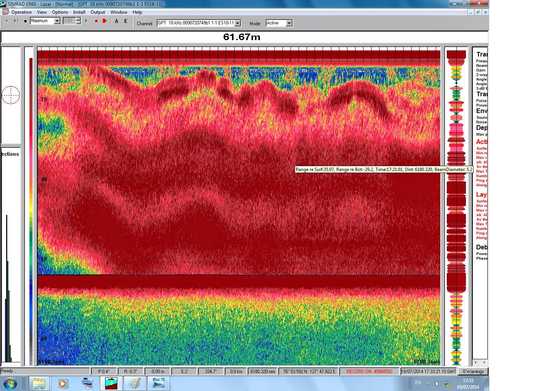“We are sniffing methane” – vast methane plumes discovered escaping from the seafloor of Arctic ocean

Just a week into the methane sampling program and SWERUS-C3 Arctic expedition scientists have discovered vast methane plumes escaping from the seafloor of the Laptev continental slope. These early glimpses of what may be in store for a warming Arctic Ocean could help scientists project the future releases of the strong greenhouse gas methane from the Arctic ocean, their press release states.
- Results of preliminary analyses of seawater samples pointed towards levels of dissolved methane 10–50 times higher than background levels.

Methane megaflare on Laptev Sea slope at around 62m depth.
"We are “sniffing” methane. We see the bubbles on video from the camera mounted on the CTD or the Multicorer. All analysis tells the signs. We are in a Mega flare. We see it in the water column we read it above the surface an we follow it up high into the sky with radars and lasers. We see it mixed in the air and carried away with the winds. Methane in the air." Ulf Hedman, Science Coordinator, Swedish Polar Research Secretariat (Daily Kos)
The discovery was made while the icebreaker Oden crosscut the Laptev Sea along a depth gradient from 1000 m to just 100 m following the continental slope upward to reach the shallow waters of the outer Laptev Sea Shelf.
By use of acoustic techniques and geochemical analyses of water samples, the scientists found vast methane plumes escaping from the seafloor at depths between 500 m and 150 m. At several places, the methane “bubbles“ even rose to the ocean surface.
Methane bubbles discovered on Laptev continental slope of Arctic ocean
Chief scientist Örjan Gustafsson from Stockholm University speculates in his latest blog entry that the leaking methane from the seafloor of the continental slope may have its origins in collapsing “methane hydrates,” clusters of methane trapped in frozen water due to high pressure and low temperature:
So, what have we found in the first couple of days of methane-focused studies?
1) Our first observations of elevated methane levels, about ten times higher than in background seawater, were documented already as we climbed up the steep continental slope at stations in 500 and 250 m depth. This was somewhat of a surprise. While there has been much speculation of the vulnerability of regular marine hydrates (frozen methane formed due to high p and low T) along the Arctic rim, very few actual observations of methane releases due to collapsing Arctic upper slope marine hydrates have been made. ¨
It has recently been documented that a tongue of relatively varm Atlantic water, with a core at depths of 200–600 m may have warmed up some in recent years. As this Atlantic water, the last remnants of the Gulf Stream, propagates eastward along the upper slope of the East Siberian margin, our SWERUS-C3 program is hypothesizing that this heating may lead to destabilization of upper portion of the slope methane hydrates. This may be what we now for the first time are observing.
2) Using the mid-water sonar, we mapped out an area of several kilometers where bubbles were filling the water column from depths of 200 to 500 m. During the preceding 48 h we have performed station work in two areas on the shallow shelf with depths of 60-70m where we discovered over 100 new methane seep sites. SWERUS-C3 researchers have on earlier expeditions documented extensive venting of methane from the subsea system to the atmosphere over the East Siberian Arctic Shelf.
On this Oden expedition we have gathered a strong team to assess these methane releases in greater detail than ever before to substantially improve our collective understanding of the methane sources and the functioning of the system.
Örjan Gustafsson believes such data to be crucial for making scientific predictions of how the release of methane from the seafloor of the Arctic Ocean may take shape in the future.
SWERUS-C3 is a multi-disciplinary program with base funding supported from by the Swedish Knut and Alice Wallenberg Foundation (KAW) aiming to investigate the linkages between Climate, Cryosphere (here: sea ice and coastal permafrost) and Carbon release from the sediment, with addition of greenhouse gases (GHG) to the atmosphere. SWERUS-C3 includes principal investigators from Stockholm University, University of Gothenburg,Pacific Oceanological Institute, P.P. Shirshov Institute of Oceanology, Russian Academy of Sciences (RAS), National Tomsk Research Polytechnic University, the International Arctic Research Center (IARC) at University of Alaska,Center for Coastal and Ocean Mapping at University of New Hampshire and Rice University.
- For latest updates from the expedition visit their homepage, YouTube channel, Facebook or Twitter.
- Click here to see where Oden is now.
Featured image: Methane bubbles on Laptev continental slope of Arctic ocean. SWERUS-C3

I made a comment about the methane excaping on a “conservative” oriented talk show (is there anything but “conservative” — meaning wilfully ignorant?) The next caller just happened to counter my own comment with “methane has been releasing from ponds etc. since the beginning of time” etc. much like a comment made above. I am guessing that there are monitors who listen to these call-ins to make sure that anyone not speaking the party line who has gotten by the screener is countered with the industry argument. It would only take a few bucks, when we consider all the massive wealth the industry has made off us, for the use of our resources to power whatever they have caused us to want to purchase. Problem is, we will all die a very painful death if this warming continues.
methane has been boiling out of ponds, lakes', forests floors and the oceans for thousands' of centuries. its a natural process of biological digestion and conversion of hydrocarbons. Just because these numb skulls just noticed it doesn't make it a big deal. Where do you think oil (hydrocarbons)comes from? HYDRO(Hydrogen-oxygen) ahh Water, and Carbon ..get it… or do you still think that oil (petroleum) came from squished dinosaurs and weeds.
Hey Knottehead. OF COURSE methane has been released for most of the history of life on the planet. Manure of all sorts, cattle guts, peat bogs, etc. Don’t be such a pedant.
It is ALWAYS about amount of material emitted and the RATE. Both of which are large and getting larger at an increasing rate. THAT is the problem. And where do you suppose the carbon in HYDRO carbon came from. ORGANIC MATERIAL.
Keeeryst on a crutch. Either you’re a shill, being deliberately ignorant, or are just scientifically hopeless.
Like all the man made earthquakes in Oklahoma do to Fracking, Global Warming is causing a huge amount of Methane Gas to be released into our atmosphere like Al Gore warned in "An Inconvenient Truth" decades ago and wonder where our world would be had he become President starting his Wind and Solar energy revolution way back then, turning all these wars into renewable energy technology creating solar cars that run on sea water for decades,…etc.
It Is The Energy Increase At The Core Stupid:
The scientists are linking the cause of this vast amount of methane plumes that are escaping from the Arctic seafloor to the increase of the surface temperature (man made climate change). These Methane release are coming from depths some at 600 meters deep, thus the current explanation cannot possibly be correct. The Gulf Stream and so-called mixing process cannot heat those frozen methane hydrates hundreds of meters below the surface. The temperature increase below the seafloor is the cause and these large amount of methane release could well be coming from the primary source deep within the earth.
https://www.linkedin.com/today/post/article/20140730105523-97196790-it-is-the-energy-increase-at-the-core-stupid-two-more-mysterious-holes-have-opened-up-in-siberia?trk=mp-details-rr-rmpost